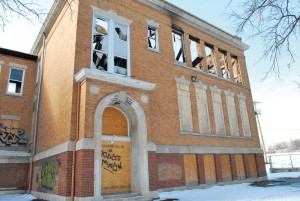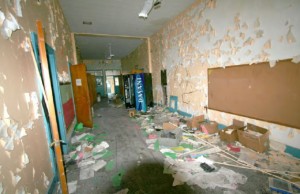By LESLIE COLLINS
Northeast News
July 31, 2013
Driving down Independence Avenue, it’s hard not to notice the three-story Italian Renaissance Revival building. Clad with blond brick, window accents and classic arches, the former Thacher Elementary School is a prominent structure and streetscape staple.
According to a Kansas City Public Schools (KCPS) repurposing document, the former school is eligible for earning a spot on the National Register of Historic Places.
However, demolition is a strong possibility and the building recently made the Historic Kansas City Foundation’s 2013 Watch List for endangered buildings.
Earlier this year, the KCPS Board of Education (BOE) approved re-instating the mothballed Northeast Middle School as a middle school, which shares an 8-acre site with Thacher. As a result, the KCPS repurposing committee has recommended that Thacher be demolished due to liability and safety concerns.
Thacher saw its last set of students in 2009, when the district continued its right-sizing initiative, shuttering a number of schools to save resources and balance the budget.
Upon shuttering the school, KCPS failed to secure the building and arson gutted the second floor of the 1914 addition and severely compromised the second floor in January of 2011. A portion of the roof caved in due to the fire, and the building continues to remain exposed to the elements. Despite the fire and repeated vandalism, both the 1914 addition and original 1898 building’s envelope is structurally sound, according to a KCPS repurposing document. Both the 1914 and 1898 building have water damage, and mold has crept into the gymnasium. Adding to the list of woes, Thacher is no longer mechanically functional as a result of vandals who stripped the building of air conditioning units as well as copper and other metals. Despite its high visibility along Northeast’s main thoroughfare, KCPS has yet to find a buyer for Thacher.
“At this point we haven’t found any viable re-use (for Thacher) in the near term,” said Shannon Jaax, KCPS Repurposing Initiative director. “It’s a very difficult building to reuse in its current state with a shared site with a school.”
Losing KCPS schools to demolition isn’t a new concept. Former KCPS BOE member Patricia Kurtz and her husband, John Kurtz, a lawyer, both fought to save the old Paseo High School, which was built in 1924. Her husband and other lawyers worked pro bono on a court case in 1990, representing 18 Paseo students who wanted to save their school from demolition.
The school district argued the building was unstable and that constructing a new school in its place would be cheaper. The 18 students lost their case and U.S. District Judge Russell G. Clark signed the demolition order. About 400 people, including alumni, gathered around the school on Oct. 23, 1990, for a candlelight vigil. While standing on the steps leading to the main entrance, they sang, “We Shall Overcome.” In one final attempt to save Paseo High, school supporters asked the Kansas City City Council to designate Paseo as a historic landmark to stall demolition, but the council failed to bring it to a vote.
“It was a perfectly sound building,” Patricia Kurtz said. “They claimed it would be cheaper to rebuild. When I got on the school board, I found out it wasn’t true because they issued a number of change orders to the (new) building which added to the cost.”
Kurtz believes KCPS demolished the school because some still believed the building stood as a reminder and symbol of the district’s segregation era.
“It was sickening,” she said of the demolition.
Despite using dynamite – allegedly twice the normal amount – to demolish the structure, a section of the old school survived the blast.
“That was a little bit of a small victory,” Kurtz said. “They were claiming how unstable this building was and they eventually had to do the tower with a wrecking ball.”
Charles Ashley Smith, the school district’s architect from 1887 to 1948, designed the original Paseo High building and the 1914 edition of Thacher. By the time he retired, Smith had designed more than 60 school buildings and additions for KCPS, and often used Classical Revival or classically-inspired styles. Smith received recognition for his innovative designs to improve ventilation and sanitary conditions in schools, which became adopted in schools nationwide. Smith, who called Historic Northeast home, also designed the Firestone Building, 2001 Grand, the original Hereford Association Building, 300 W. 11th, the Fine Arts Building on the University of Missouri-Kansas City campus, the Unity Temple at 47th and Jefferson, and a number of other buildings in Kansas City. His home at 810 Benton Blvd., which he designed, still stands today.
William F. Hackney, school district architect from 1887 until his death in 1899, designed the 1898 Thacher building, along with 13 other school buildings. He also designed the Kansas City, Missouri Public Library, several private residences and helped complete the Iowa and Illinois State Capitol buildings.
“These (school) buildings were designed by very prominent architects of the day,” Kurtz said. “These people were artists; they made works of art. We just have no compunctions about tearing them down. Pretty soon, we’ll just have ugly little boxes along our roads.”
Residents also tried to save the old Gladstone Elementary School, but to no avail.
“People remained bitter about that for years and years,” Kurtz said.
Buildings like Thacher can be saved, said Historic Northeast resident and photographer David Remley, who specializes in architecture photography. Remley listed off the old Cosby Hotel, built in 1881 at 9th and Baltimore, which the city classified as a dangerous building and ordered an emergency demolition for in 2010. Thanks to efforts from the Downtown Council and a Facebook campaign, “Save the Cosby,” the city halted the demolition. To prevent the west wall from falling, the city paid $4,000 for repairs and then billed the owner. Sunflower Development Group purchased the building, making necessary renovations. Now, a deli, bakery and pizzeria are slated to open on the first floor within the next few weeks, and the upper floors will feature office suites.
“It’s gorgeous now and it was in far worse shape than Thacher,” Remley said of the Cosby. “Basically Thacher has just been allowed to deteriorate because I think the district wants to get rid of it.”
Located just west of Troost Park, The Christian Church Hospital, later known as the Robinson Memorial Hospital, closed in 1973 and sat vacant for more than 30 years. Vandals and neglect took its toll, but the building was later restored into 46 affordable, senior living apartments in May of 2006. Some schools in the U.S. have been turned into bed and breakfasts, and the old school on Benton Boulevard was turned into senior housing, Kurtz said.
“Just look at what they did with Menorah Hospital by the UMKC campus,” she said. “So, I think something can be done (with Thacher).”
Remley and Kent Dicus, president of the Northeast Kansas City Historical Society (NEKCHS), aren’t opposed to mothballing Thacher for several years in order to preserve it and wait for a viable buyer. The two listed possible re-uses of an artist’s incubator, business incubator and community center.
“I’m hoping that it can be saved,” Dicus said. “I’m not unrealistic enough to expect it to be; I do understand the whole liability thing. I get that, and I know something has to be done…
“My philosophy is to really warrant a demolition for a building, it has to be in really, really bad shape, non-retrievable, not salvageable. I’m one of those people that think just about any building that’s still standing, even if it’s cost prohibitive, should be saved at all costs if it has historical integrity.”
Tearing down Thacher would be like having a missing tooth along the avenue, Dicus said.
“It’s easier to straighten a tooth, then it is to put in a fake one,” he said.
For Remley, Thacher isn’t just a piece of Northeast history, it’s personal. Both his father and his father’s two siblings attended Thacher.
“In a lot of countries, preservation is just automatic,” Remley said. “They don’t even think about tearing things down. Here, that’s sometimes the first option. What we would lose is a fabric of our history, one of our connections to the past… We have our own written history, but we need our visual history, too.”


















